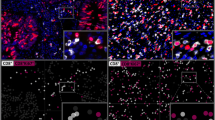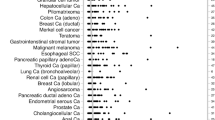Abstract
Recent data suggest that chemokines and chemokine receptors mediate leukocyte recruitment of all components of the antitumor response. This study aimed to phenotypically characterize the immune lymphocyte infiltrate in human renal cell carcinomas (RCCs) and at the invasive margin (tumor–host interface) and to define the association of these findings with established prognostic indicators. Tumor infiltrating lymphocytes (TILs) were obtained from 24 patients with RCC undergoing radical nephrectomy. Peripheral blood cells from 37 patients were also obtained before surgery. Our findings are consistent with the preferential recruitment of CD4+ Th1-polarized effector memory cells that express CXCR3/CCR5. These cells were the main component of TILs and expressed as CXCR3, CCR5, CD45RO, and CD95. Natural killer (NK) cells were found in significantly higher proportions in TILs of RCCs than in peripheral blood lymphocytes (PBLs) or in other tumors studied (colorectal and breast cancers), where these cells were found in small proportions. No differences in nuclear grade or other studied parameters were observed between the TILs and the lymphocytes present at the invasive margin, which showed a similar composition. However, differences were found according to the tumor stage. First, significantly fewer NK cells were observed in PBLs from metastatic patients. Second, a significantly lower proportion of CCR5/CXCR3/CD4+ cells and a higher proportion of CCR4/CD4+ cells were observed in metastatic patients, suggesting that preferential Th1-polarization may gradually change during the progression of renal cancer cells. Finally, the frequency of CD25/CD4+ cells was higher in metastatic patients. Although the sample of patients with metastasis was small, the overall results suggest a change in composition of the TILs that may potentially confer a selective advantage for tumor growth and may account for the suppression of an effective cytotoxic response.




Similar content being viewed by others
References
Albertsson PA, Basse PH, Hokland M, Goldfarb RH, Nagelkerke JF, Nannmark U, Kuppen PJ (2003) NK cells and the tumour microenvironment: implications for NK-cell function and anti-tumour activity. Trends Immunol 24:603
Bonecchi R, Bianchi G, Bordignon PP, D’Ambrosio D, Lang R, Borsatti A, Sozzani S, Allavena P, Gray PA, Mantovani A, Sinigaglia F (1998) Differential expression of chemokine receptors and chemotactic responsiveness of type 1 T helper cells (Th1s) and Th2s. J Exp Med 187:129
Cabrera CM, Jimenez P, Cabrera T, Esparza C, Ruiz-Cabello F, Garrido F (2003) Total loss of MHC class I in colorectal tumors can be explained by two molecular pathways: beta2-microglobulin inactivation in MSI-positive tumors and LMP7/TAP2 downregulation in MSI-negative tumors. Tissue Antigens 61:211
Garrido F, Ruiz-Cabello F, Cabrera T, Perez-Villar JJ, Lopez-Botet M, Duggan-Keen M, Stern PL (1997) Implications for immunosurveillance of altered HLA class I phenotypes in human tumours. Immunol Today 18:89
Ishigami S, Natsugoe S, Tokuda K, Nakajo A, Che X, Iwashige H, Aridome K, Hokita S, Aikou T (2000) Prognostic value of intratumoral natural killer cells in gastric carcinoma. Cancer 88:577
Kondo T, Ito F, Nakazawa H, Horita S, Osaka Y, Toma H (2004) High expression of chemokine gene as a favorable prognostic factor in renal cell carcinoma. J Urol 71:2171
Li J, Hu P, Khawli LA, Epstein AL (2003) Complete regression of experimental solid tumors by combination LEC/chTNT-3 immunotherapy and CD25(+) T-cell depletion. Cancer Res 63:8384
Mailliard RB, Son YI, Redlinger R, Coates PT, Giermasz A, Morel PA, Storkus WJ, Kalinski P (2003) Dendritic cells mediate NK cell help for Th1 and CTL responses: two-signal requirement for the induction of NK cell helper function. J Immunol 171:2366
Maleno I, López Nevot MA, Seliger B, Garrido F (2004) Low frequency of HLA haplotype loss asoociated with loss of heterozigosity in chromosome region 6p21 in clear renal cell carcinomas. Int J Cancer 109:636
Marincola FM, Jaffee EM, Hicklin DJ, Ferrone S (2000) Escape of human solid tumors from T-cell recognition: molecular mechanisms and functional significance. Adv Immunol 74:181
Mizoguchi H, O’Shea JJ, Longo DL, Loeffler CM, McVicar DW, Ochoa AC (1992) Alterations in signal transduction molecules in T lymphocytes from tumor-bearing mice. Science 258:1795
Moser B, Wolf M, Walz A, Loetscher P (2004) Chemokines: multiple levels of leukocyte migration control. Trends Immunol 25:75
Mukherjee P, Ginardi AR, Madsen CS, Tinder TL, Jacobs F, Parker J, Agrawal B, Longenecker BM, Gendler SJ (2001) MUC1-specific CTLs are non-functional within a pancreatic tumor microenvironment. Glycoconj J 18:931
Ochsenbein AF, Klenerman P, Karrer U, Ludewig B, Pericin M, Hengartner H, Zinkernagel RM (1999) Immune surveillance against a solid tumor fails because of immunological ignorance. Proc Natl Acad Sci USA 96:2233
Pardoll D (2003) Does the immune system see tumors as foreign or self? Annu Rev Immunol 21:807
Paul S, Calmels B, Regulier E (2002) Tumor-induced immunosuppression. Ann Biol Clin 60:143
Ruiz-Cabello F, Cabrera T, Lopez-Nevot MA, Garrido F (2002) Impaired surface antigen presentation in tumors: implications for T cell-based immunotherapy. Semin Cancer Biol 12:15
Sallusto F, Lanzavecchia A, Mackay CR (1998) Chemokines and chemokine receptors in T-cell priming and Th1/Th2-mediated responses. Immunol Today 19:568
Schleypen JS, Von Geldern M, Weiss EH, Kotzias N, Rohrmann K, Schendel DJ, Falk CS, Pohla H (2003) Renal cell carcinoma-infiltrating natural killer cells express differential repertoires of activating and inhibitory receptors and are inhibited by specific HLA class I allotypes. Int J Cancer 106:905
Schwartz M, Kipnis J (2002) Autoimmunity on alert: naturally occurring regulatory CD4(+)CD25(+) T cells as part of the evolutionary compromise between a ’need’ and a ’risk’. Trends Immunol 23:530
Villegas FR, Coca S, Villarrubia VG, Jimenez R, Chillon MJ, Jareno J, Zuil M, Callol L (2002) Prognostic significance of tumor infiltrating natural killer cells subset CD57 in patients with squamous cell lung cancer. Lung Cancer 35:23
Wang HY, Lee DA, Peng G, Guo Z, Li Y, Kiniwa Y, Shevach EM, Wang RF (2004) Tumor-specific human CD4+ regulatory T cells and their ligands: implications for immunotherapy. Immunity 20:107
Zhang X, Koldzic DN, Izikson L, Reddy J, Nazareno RF, Sakaguchi S, Kuchroo VK, Weiner HL (2004) IL-10 is involved in the suppression of experimental autoimmune encephalomyelitis by CD25+CD4+ regulatory T cells. Int Immunol 16:249
Acknowledgements
We thank Carmen Amezcua and Carmen Gonzalez for expert technical assistance. This work was partially supported by the Fondo de Investigaciones Sanitarias, (PI020175) the plan Andaluz de Investigación, Instituto de Salud Carlos III-Red de centros de Cancer-RTICCC-contract n° CO3/10 and the Plan Nacional, Spain.
Author information
Authors and Affiliations
Corresponding author
Rights and permissions
About this article
Cite this article
Cózar, J.M., Canton, J., Tallada, M. et al. Analysis of NK cells and chemokine receptors in tumor infiltrating CD4 T lymphocytes in human renal carcinomas. Cancer Immunol Immunother 54, 858–866 (2005). https://doi.org/10.1007/s00262-004-0646-1
Received:
Accepted:
Published:
Issue Date:
DOI: https://doi.org/10.1007/s00262-004-0646-1




